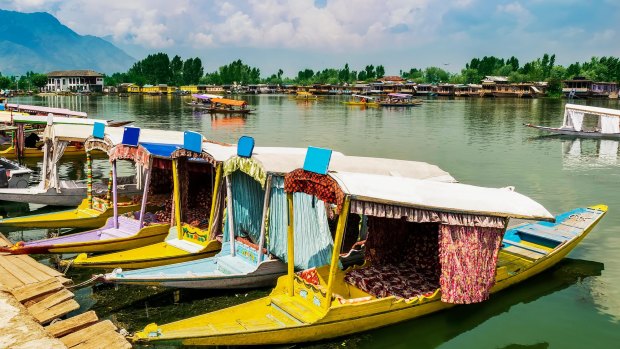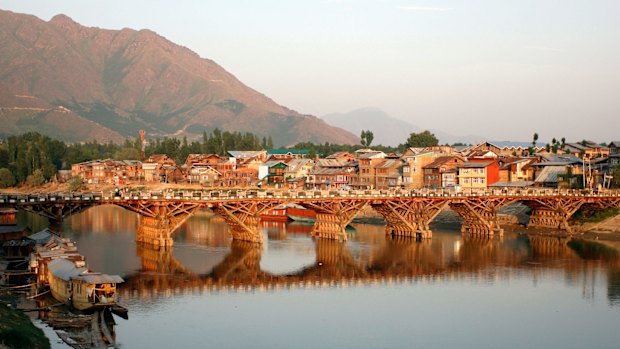This was published 5 years ago
Srinagar, Kashmir travel tips: It feels safer than Paris, but few visit this ultimate adventure destination
By Craig Tansley

Shikara boats in Dal Lake. Credit: Alamy
For a man who swears we couldn't be safer anywhere in India, Tasaduq Mufti seems to have an unhealthy interest in machine guns.
He is accompanied by five khaki-clad soldiers holding the guns against their chests; two more soldiers in street wear (if you consider gunmetal-grey velour tracksuits street wear) are brandishing Uzis. Mufti, Kashmir's (temporary) tourism minister, has agreed to meet me here, inside a national park overlooking Kashmir's capital city, Srinagar. While I wait – staring across the famed freshwater lakes of the city, towards the snow-capped Himalayas that straddle the border the province shares with Pakistan – his protectors file past, looking me over.
"This is the safest city in the country," Mufti will tell me. "Unless you come looking for trouble, you are very safe. Kashmir is much safer than Delhi or Mumbai."

Wooden bridge over the Libber River.Credit: Alamy
And therein lies the dilemma of Kashmir … and Srinagar. It's been 23 years since a foreign tourist was affected by violence (admittedly, that incident was particularly blood-thirsty: Kashmiri separatists murdered five foreign tourists in cold blood), but I've only seen a handful of foreign travellers in four days. And while Mufti is willing to guarantee Kashmir's safety, foreign governments certainly aren't. The Australian Government suggests we reconsider our need to travel to Srinagar; and says we should not travel at all outside the city.
Truth be told – for all the machinegun turrets and over-zealous airport security officers – I feel safer here than I did last year in Paris. But Kashmir has been politically unstable in some shape or form since Pakistani soldiers invaded in 1947, prompting the province to accede to India to guarantee its protection. The question of its independence was supposed to be decided peacefully by its people in the years after. But it never has, and some Kashmiris have taken up arms in the battle for sovereignty. There have also been three wars fought between India and Pakistan over Kashmir since.
Despite this, Kashmir gained an almost mythical status throughout the '60s, '70s and '80s, and was immortalised in Led Zeppelin's Kashmir in 1975: "Like Shangri La beneath the summer moon … I will return again … ". The song's author, Robert Plant, said: "Kashmir is my last resort … if I really need it … it should be my haven…". Hashish grew in its streets, green mountains dipped down into the backyards of its people, and the air smelled distinctly of jasmine and potpourri.
The stoners, however, shipped out long ago – the hardiest of them scattering when over 40 unarmed protesters were gunned down by Indian forces in 1990, and after yet another war in 1999. What's left now are the remnants of the flower children's vision – a city of abundant green Mughal parks and Colonial-era houseboats set on the banks of clear-water lakes – but with barely a foreign tourist with whom to share it.
All this raises an important question: do you feel lucky? For Kashmir might well be the ultimate destination for the adventure tourist, if you can put up with the odd machinegun on your daily walk. "Nothing can prepare you for your first glimpse of Kashmir," former Kashmir resident, and World Expeditions leader, Garry Weare, writes in A Long Walk In The Himalayas. "Verdant, forested valleys and alpine peaks – Switzerland, but in Himalayan proportions."
Weare is accompanying me on a tour into a city he's lived in – on and off – for almost 50 years. He's with me in the back seat as we travel through the airport gates, passing by an armoured car. "A lot of people put off coming here because they think it's a war zone," he says. As he speaks, we pass another checkpoint manned by soldiers with assault rifles. "But it's not."
Beyond the heavily-fortified airport zone, the army retreats and I'm surrounded instead by the Himalayas. "I've never seen anywhere in the world as beautiful as Kashmir," wrote India's most infamous author, Salmon Rushdie. Iconic travel writer Jan Morris took her admiration further: "Kashmir has always been more than a mere place," she wrote. "It has the quality of an experience, or a state of mind."
I'm not necessarily here looking for nirvana, I'd settle for a hot cup of tea and a lie-down. I've just completed a walking journey across the Himalayas, 45 minutes flying time east of here in Ladakh. I'll be staying aboard a houseboat parked on Nagin Lake, eight kilometres from Srinagar's centre. Houseboats have been popular here since long before the beatnik generation sequestered them. In the late 18th century, British colonists visiting Srinagar used them as a way to get around local laws preventing foreigners from owning land.
Farouk greets me at the entrance to my boat; my butler for the week is resplendent in a pressed white suit. Inside the vessel, walnut bureaus, ornate coffee tables and a gigantic teak dining table illuminated by a glass chandelier send me back to olden times. Above the top deck, dozens of golden eagles circle the blue skies and across the mirrored surface of the lake I can see the still-snowy slopes of the famed Gulmarg ski region. Front yards of fresh-mown green lawns and fastidiously-clipped rose gardens conjure an English afternoon in mid-summer. In this pastoral scene, however, flower vendors weighed down by fresh-cut stock paddle past in wobbly, wooden shakira boats.
Srinigar is famous for its mild summer climate but I'm caught in the middle of an unseasonably warm spell and see out the early afternoon heat on the shaded seat of a shakira steered by a local boatman. At sunset, the mountains of the inner Himalayas – the Pir Panjal Range – appear to hover in the soft apricot hues of twilight, as thousands of voices drift across from the city's mosques at prayer time (Kashmir is an Islamic state).
Hiking was once popular in the mountains around Srinagar, but travel warnings prevent most foreign trekkers going there now.With legs still sore from my week-long trek, I'm content to stick to Dachigam National Park – a 141-square-kilometre park that rises from 1800 metres to 4000 metres above sea level – which is only 22 kilometres from the city.
Naturalist Nazir Malik insists I meet him at dawn, when the park's most notorious residents, the endangered Kashmir Stag, and the Himalayan Black Bear, are most active. We climb high across forest-covered mountains, where morning mist lies trapped in tight valleys. From a wooden platform I see black bears out seeking berries, acorns and walnuts which grow amongst the conifers. There are leopards here too, and jackals and wolves, and more butterflies fluttering through the landscape than I could ever count.
The drivers around Srinagar are likely to kill you long before the beasts of Dachigam, or crazed separatists. Drivers overtake at will and road signs appear to be mere decoration. Don't hire your own car or, God forbid, a motorbike. A driver takes me to Srinagar's Old City. With a lot of TLC, this could be the prettiest historic shopping quarter in western Asia. I walk through a labyrinth of cobbled laneways, past chickens and rabbits in cages and 16th-century shop-fronts. Rank smelling herbs and spices fill the air, while bags of nuts and dried fruit, and sacks of saffron balance on top of each other. There are fortresses on the hills above and centuries-old wooden mosques and cemeteries with 600-year-old graves. Gabled windows, Juliet balconies and ancient wooden bridges over the brown Jhelum River make the city appear distinctly European; like a fallen-down version of Florence. Indian author Basharat Peer says Srinagar is "a medieval city dying in a modern war", but I find a tangible vitality here amongst the shambles.
Although being amongst this chaos induces adrenalin unbecoming of Kashmir. I spend the remainder of my afternoon behaving like a colonial – with a long, luxurious lunch under the Chinar trees at Srinagar's finest hotel, the Lalit Grand Palace, the ruling Maharjah's former palace. This is where Gandhi came to discuss the terms of Kashmir's accession, if only he could have seen what lay ahead for Kashmir. From my seat in the shade I can see all the way to Dal Lake, Srinagar's centrepiece. After lunch, I golf at India's number-one-rated course, Royal Springs Golf Club, on the outskirts of the city; where black bears feed by the fenced perimeters, and the mountain views are superior to any course I've seen in Asia.
There are these kinds of five-star offerings in Kashmir. Domestic tourists embrace them – seemingly unconcerned by political tension - yet last year Kashmir registered just 2000 American and English visitors, and approximately the same number of Australians. But Governments are slowly softening their stance – Germany became the first country in the EU to lift its travel ban and last year 30 000 visitors from outside India (mostly from within south-east Asia) came to Kashmir, the highest number since the 1990s. But for now - if you're not squeamish about the sight of a bloke with an automatic weapon - Kashmir remains the destination adventure-lovers spend a whole life chasing.
Air India fly direct to Delhi from Sydney and Melbourne, then fly to Srinagar in 90 minutes, see airindia.in
TOURS
Garry Weare has escorted World Expeditions treks in the Indian Himalaya for decades. In 2019, he will be escorting new itineraries which include time in Srinagar, see worldexpeditions.com
Craig Tansley travelled as a guest of World Expeditions and Jammu & Kashmir Tourism.
See also: In search of one of the world's most endangered cultures
Sign up for the Traveller Deals newsletter
Get exclusive travel deals delivered straight to your inbox. Sign up now.